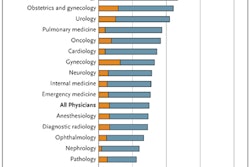The more tort reform laws a state has in place, the less imaging is performed in hospital emergency departments, according to a study published online in the American Journal of Emergency Medicine.
Physicians fear malpractice suits and may order unnecessary imaging tests to prevent them, according to researchers at the University of California, San Francisco (UCSF). However, tort reform appears to curb this kind of "defensive medicine" imaging (Am J Emerg Med, July 2, 2010).
"In the current system, there's believed to be no downside to ordering a test," Rebecca Smith-Bindman, MD, lead author of the study, told AuntMinnie.com. "But if doctors are performing tests that aren't indicated just to cover themselves, that's a huge quality issue. If we can come up with motivations [to order tests appropriately] that don't penalize physicians, the practice of defensive medicine could be mitigated."
Smith-Bindman's team investigated the association between states' medical malpractice tort reforms and neurologic imaging rates for emergency department patients with mild head trauma. They found a 40% lower incidence of imaging in states with this reform, compared with states that do not have it in place.
Defensive medicine = status quo
As recently as 2005, studies have found that nearly all physicians reported using defensive medical practices, and ordering more diagnostic tests than medically indicated was the most frequently reported practice.
Emergency department physicians are particularly likely to report using defensive medicine, according to Smith-Bindman and colleagues. The American College of Emergency Physicians (ACEP) has guidelines for neurologic imaging for patients seen in an emergency department with a head injury; the guidelines state that imaging should be used when the injury is severe, but it should be considered discretionary in other cases, according to the authors.
However, the relationship between tort reform and unnecessary imaging has not been studied enough, they wrote.
"There have been many studies that look at the direct effect of malpractice costs, such as premiums and award payments," Smith-Bindman told AuntMinnie.com. "But as far as I know, this study is the first to explore the association between test ordering and indirect medical costs -- that is, 'defensive medicine.' "
The team used a sample of 8,588 Medicare-eligible women 65 years and older living in 10 U.S. states who presented to an emergency department with head injury between January 1992 and December 2001. The study team defined the injury as severe when the woman had lost consciousness or had presented with an open head wound. Remaining patients were classified as having mild-to-moderate injuries.
For each emergency department visit represented, the researchers assessed whether CT or MR exams had been performed within seven days of the visit. The team adjusted the data for density of radiologists and availability of imaging resources in each particular area. Then the researchers determined whether each state had medical tort reform legislation, classifying laws into four types:
- Caps on monetary damages
- Mandated periodic award payments (these allow losing defendants to pay in installments)
- Collateral source offset rules (which deny compensation for losses that can be recouped from other sources)
- Caps on attorney contingency fees (which limit how much the representing attorney can collect as a percentage of the award)
The team chose these four particular types of tort reform laws because their implementation varied in the states included in the study.
Tort reform works
States with laws that limited monetary damages, mandated periodic award payments, or specified collateral source offset rules had 40% lower odds of imaging, whereas states that had laws that limited an attorney's contingency fees had higher odds of imaging compared to states without these laws, Smith-Bindman and colleagues wrote.
"When we used a summation of the number of laws in place, the greater the number of laws, the lower the odds of imaging," they wrote. "[Even] after adjusting for individual and community factors, the total number of laws remained significantly associated with the odds of imaging, and the effect of the individual laws was attenuated but not eliminated."
The team conceded that the increase in imaging over the decade studied could have been caused by other factors, such as increased availability and accessibility of MR and CT scanners, which may have filled a previously unmet need; patients' increasing assertiveness in requesting imaging; and a decreasing tolerance for uncertainty. But the results are still striking.
"We found that it wasn't the severity of the injury that predicted how much imaging would be used, but the malpractice environment," she said.
The study's results suggest that tort reform could go a long way toward curtailing imaging overuse, according to Smith-Bindman.
"Our work is preliminary, and we only looked at test ordering in a limited number of states," she said. "But the study could be repeated on a national scale. The implications are that changing our country's malpractice environment could curb the dramatic rise in medical imaging."
By Kate Madden Yee
AuntMinnie.com staff writer
August 26, 2010
Related Reading
AJR study finds holes in malpractice expert witness testimony, July 22, 2010
Abdominal CT malpractice suits aren't always doomsday, June 15, 2010
How to navigate ultrasound medicolegal issues, May 28, 2010
Leaders in Imaging: Dr. Leonard Berlin, May 25, 2010
Interpretation errors top clinical negligence claims in U.K., March 8, 2010
Copyright © 2010 AuntMinnie.com



















